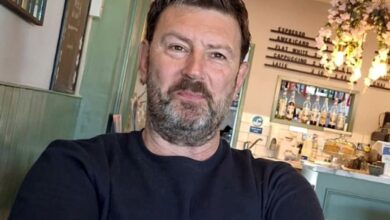Mourning Orca Whale Mom Seen Carrying Dead Calf Near Washington State
:max_bytes(150000):strip_icc():format(jpeg)/orca-carrying-baby-091625-bc150424c0db40afa4f9c5c23ce0dda9.jpg)
NEED TO KNOW
- J36, a southern resident killer whale known as Alki, is mourning the death of her newborn calf
- The female orca was spotted carrying her dead baby, a female, on Sept. 12 near Washington state
- Another member of the orca’s pod has gone on a similar “tour of grief” after the death of their calf
A mother orca is mourning the loss of her recently deceased calf in a very public manner.
On Friday, Sept. 12, a southern resident killer whale identified as J36 was spotted traveling through the Rosario Strait in Washington while pushing her dead baby with her head.
The Center for Whale Research confirmed the news in a post on Facebook, writing that “researchers arrived in the area in the early afternoon, and sadly were able to confirm that southern resident J36 was pushing a deceased female neonate, with umbilical cord still attached.”
It was currently unclear if J36’s calf was a stillbirth or if she had died “shortly after birth.” They believe that the calf died within the last week, but additional research will need to be conducted to confirm. The Seattle Times noted that J36 is also known as Alki.
Getty
Never miss a story — sign up for PEOPLE’s free daily newsletter to stay up-to-date on the best of what PEOPLE has to offer, from celebrity news to compelling human interest stories.
The SeaDoc Society, a nonprofit organization dedicated to protecting marine life, shared footage of J36 swimming with her deceased calf, which the organization captured during fieldwork with the San Diego Zoo Wildlife Alliance and shared on Facebook.
It is not unheard of for an orca to show signs of grief over the loss of a young calf. In January, a member of J36’s pod named Tahlequah or J35 pushed a dead calf along for at least 11 days in what was referred to as a “tour of grief.” Tahlequah was joined by her two living sons.
Tahlequah first became infamous in 2017, when she traveled 1,000 miles over the course of 17 days with a different dead calf resting atop her head for most of the journey.
Deborah Giles, a scientist with the SeaDoc Society, described the J36’s loss as “challenging,” explaining that the whale “put all this energy into gestating this calf that does not result in a viable offspring,” per the Seattle Times.
Additionally, the loss of the calf is bad news for the overall population of killer whales, a critically endangered species relying on the birth of more female orcas to stave off extinction.
Alki, 26, has previously miscarried calves, and she suffered the loss of a 2-year-old son in 2017.
Speaking about the mourning process, Giles noted that the mother is “keeping [her calf] as close as possible.”
Getty
“As soon as she stops going to retrieve it, it will sink into the depths. But she cannot let it go yet. She’s mourning the loss of her dead baby,” she explained.
Per the outlet, Giles said that additional testing would need to be done to determine if the calf’s death was due to something larger. However, the organizations were giving the grieving mother time with her calf before disturbing her.
Speaking with CBC News, Center for Whale Research research director Michael Weiss hypothesized that more female mothers carry dead calves in mourning than the public is aware of.
“It may happen multiple times a year and we just don’t see it,” he explained.
As for the cause of the “tour of grief,” he hypothesized, “It might be an emotional response. It might be an inability to let go. It might be an attempt to revive the calf,” ultimately adding, “We don’t know.”
Credit to Nypost AND Peoples



